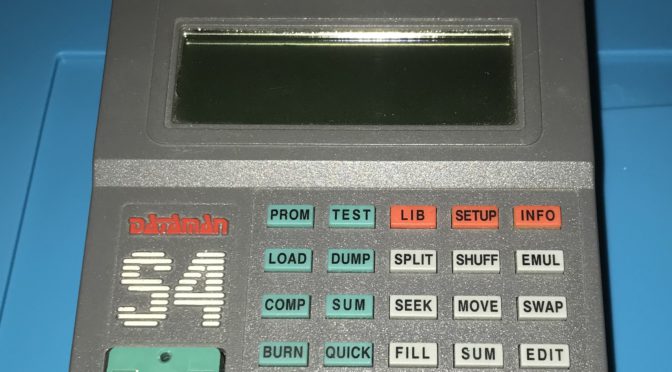Soon after I started out in electronics, I quickly began looking for a device that could program my own EPROMS / Memory from a computer. So when I started doing freelance work, I was able to purchase a Chinese HI-LO ALL02 programmer. The down side was that it required a slot in my PC for the ISA card, which then plugged into its external programmer. It wasn’t portable and it required the PC to do all the heavy lifting. I still thought this was amazing and it was used on many many projects, beginning in the late ’80s right up until the early ’00s. It paid for itself several times over but the only problem I have now, is that the ISA card for the programmer has gone missing (a suspected casualty of a spring clean). Still, I have the programmer and I’m actively looking for an ISA card for it.

When I joined Intermec Ireland, in the mid ’90s, we had a programmer in the service department which allowed us to program PROMs and EEPROMs via the serial port on the PC and while it was slow, it did work. It supported various devices and once the code was downloaded into the programmer, you could program multiple EPROMS in minuets. It made me realise the advantages of programmers with their own intelligence and memory.
At the same time, the various magazines that I was reading were advertising an EPROM programmer that I thought was perfect. It was battery powered and you could download firmware into it and use it in the field. It not only supported Memories, but Microcontrollers as well. To me, it was the Holy Grail of programmers. It had a display just like my beloved EPSON HX-20 and it could be connected to your computer, via an RS232 port. The programmer allowed the user to view/edit the contents of the memory before programming a device (this was something I had been doing manually to set serial numbers on new products). At that time, USB didn’t exist in commercial PCs.
It was called the Dataman S4 and I wanted one, but there was one small problem, it was expensive, very expensive. I believe that it cost around £450 (€570), just for the basic model. As time progressed, I kept seeing this device in component catalogues from Radionics, and in Farnell, as well as the some electronic magazines. It was taunting me, saying please buy me, please buy me, but I could never justify the purchase. As more time progressed, and my requirements changed, I ended up getting high speed USB programmers instead, at a much lower costs, which supported more devices than the S4, but deep down, I still wanted an S4 programmer.
Recently when looking on www.adverts.ie, I found someone selling an S4, I couldn’t believe my luck! The price was right, it looked in great condition and it was pulled from a working environment. So I pulled the trigger, a deal was struck, and now it is mine. Am I happy? Yes I am. I now have a piece of equipment to add to my vintage equipment kit, that was on my wish list for many years.

As you can see it is in good condition, it’s clean and has very few marks on it. I did notice that the contrast control was not working and was flapping around inside. When I opened the unit, I discovered that the contrast control knob was broken off the contrast trimmer, so this will need to be fixed. The inside of the unit looks clean and original, which I was happy to see. The batteries look original, so these may need to be changed.

Notice the centre pin of the contrast knob is stuck inside the contrast trimmer. This will need fixing.

512KB RAM
It looks as if no-one has been inside this device, so if it is faulty, I may be the first person trying to fix it. I have been informed that it was working and all it needs is a new 9VAC power supply. The HM628512 RAM Chip, on the bottom of the main PCB, is a 512K x 8 (4MB) RAM. So it looks as if the S4 programmer has the largest memory capacity available – another bonus!
Next Steps:
1) Find/purchase a 9VAC power supply for the programmer.
2) Download and setup drivers on the DOS/early Windows PC.
3) Test-program some EEPROM’s and PALs/GALs.
3) Fix the contrast control.
What are my plans for the Dataman S4?
I would like to use this programmer to program the firmware for the retro computer that is being built. I would also like to program the video character ROM and also maybe a GAL, for address decoding.



















